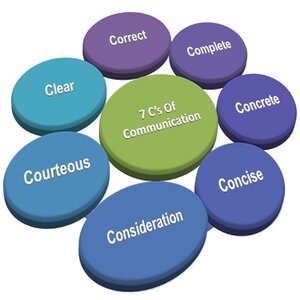How 7 C's of Communication can be Effective Tools for the Students?
 Communication is an effective tool for the students, but most of them does not have a clear picture of how to construct a productive communication. There are certain principles to be followed while conversing with others, this will help the students in putting forward their information clearly. There are 7 C’s of communication that can be an effective tools for the students in conveying their message. The 7 C’s are Completeness, Conciseness, Consideration, Concreteness, Clarity, Courtesy and Correctness.
Communication is an effective tool for the students, but most of them does not have a clear picture of how to construct a productive communication. There are certain principles to be followed while conversing with others, this will help the students in putting forward their information clearly. There are 7 C’s of communication that can be an effective tools for the students in conveying their message. The 7 C’s are Completeness, Conciseness, Consideration, Concreteness, Clarity, Courtesy and Correctness.
1. Completeness –
Whenever you send any message or give information, it should complete. For example, if your employer asks you any information about any product or service during interview. He/she should provide them complete information if possible they can add more information to it. This will send a clear message to your employer that you have complete knowledge about the product or service. Also, this way a student can maintain a good business relation with his executives. The five W’s and one H who, what, where, why, when, and how, can help you to give a clear and complete information to the opposite person.
2. Conciseness –
Most of the time the employers or any person in the higher position might not be having enough time. So, try to keep your sentences short, convey the message in few words. Having conciseness in the messages can save the time of both the parties. How to convey a whole message in few words? It is very simple, provide them with perfect examples, do not stretch the sentences and do not repeat the words.
3. Consideration –
Consideration is the most important among the 7 C’s, consider the interest of the receiver and then put forward the message in a way where the other pays complete attention. Put forward positive facts, showcase benefits and emphasize more on the communication considering the other person concentration.
4. Concreteness –
While sending and message or giving information provide specific material. Avoid creating misunderstandings by putting forward proper words. For effective communication, the message delivered should be easily understood by the receiver, build such sentences which should not be irrelevant and highlight on the facts and figures.
5. Clarity –
If you are explaining about a product or service, firstly be clear about the concept. When a student is having a clarity about their notion it will be easy for them to make the opposite party understand it clearly and easily.
6. Courtesy –
Genuine politeness includes staying alert of the viewpoint of others, yet in addition their emotions. Courtesy originates from a true you-demeanor. Despite the fact that applying socially acknowledged habits is a type of graciousness. Or maybe, it is kindness that develop out regard and worry for other people. Respectful correspondence produce an exceptional tone in their composition and talking.
7. Correctness –
At the center of correctness is appropriate language structure, accentuation and spelling. Notwithstanding, message must be immaculate linguistically and precisely right. The term accuracy, as applied to business messages likewise mean various attributes. Utilize the correct degree of language, check the exactness of figures, and words. Keep up satisfactory sentence composing skills.

